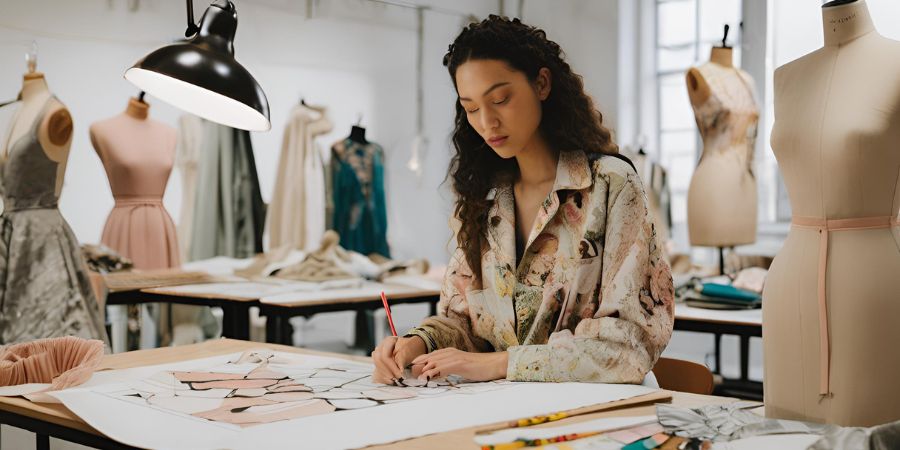Becoming a fashion designer is a dream for many creative individuals who have a passion for style, textiles, and artistic expression. However, entering this competitive field requires more than just an eye for fashion. From preparing a strong portfolio to navigating interviews, the application process can be both challenging and rewarding. If you’re considering pursuing a career in fashion design, understanding what to expect can set you on the path to success.
Preparing for Your Application
1. Build a Standout Portfolio
Your portfolio is the cornerstone of your application as a fashion designer. It showcases your creativity, technical skills, and unique design perspective. A strong portfolio should include:
- Sketches and Illustrations: Hand-drawn or digital sketches that demonstrate your ideas and creativity.
- Completed Designs: Photographs or physical samples of finished garments or accessories.
- Process Work: Include mood boards, fabric samples, and design inspiration to show your thought process.
- Variety: Showcase versatility by including designs for different occasions, styles, and demographics.
2. Gain Relevant Experience
Fashion design is a practical field, and employers value hands-on experience. Consider internships, freelance projects, or collaborations that allow you to develop your skills and expand your network. Many aspiring designers also work in retail to understand customer preferences and industry trends.
3. Develop Technical Skills
In addition to creativity, fashion designers need technical expertise. Key skills include:
- Sewing and pattern-making
- Knowledge of textiles and fabrics
- Proficiency in design software like Adobe Illustrator or CLO 3D
- Understanding garment construction and manufacturing processes
Invest in formal education, workshops, or self-directed learning to sharpen these skills.
Researching Opportunities
1. Identify Your Niche
Fashion design spans many areas, including haute couture, ready-to-wear, activewear, and accessories. Research the industry to identify where your interests and strengths align. Knowing your niche will help you target the right opportunities and tailor your application.
2. Explore Companies and Brands
Different companies have unique values, aesthetics, and expectations. Research the brands or design houses you want to work for. Understand their design philosophy, target audience, and notable achievements. This knowledge will help you create a more tailored and impactful application.
3. Understand Industry Requirements
Some employers may prioritize formal education in fashion design, while others value experience and creativity over credentials. Look at job descriptions to understand what each position requires and adjust your application strategy accordingly.
Navigating the Application Process
1. Craft a Personalized Resume and Cover Letter
Your resume and cover letter should complement your portfolio by highlighting your experience, skills, and achievements. Personalize your application for each employer, emphasizing how your style and vision align with their brand.
- Resume Tips: Use a clean layout, focus on relevant experience, and include any certifications or awards.
- Cover Letter Tips: Discuss your passion for the brand, your design philosophy, and specific skills that make you an ideal candidate.
2. Prepare for Interviews
Fashion designer interviews often combine traditional questions with creative challenges. Be ready to discuss:
- Your design process and inspirations
- How you handle feedback and collaborate with teams
- Your understanding of current fashion trends and market demands
Some employers may also ask you to complete a design task or present your portfolio in detail.
Facing Challenges in the Application Process
1. Handling Rejection
Rejection is common in competitive industries like fashion. Use it as a learning opportunity by seeking feedback and refining your skills. Remember, perseverance is key to success.
2. Standing Out in a Competitive Field
With so many talented individuals vying for the same positions, standing out can be challenging. Focus on what makes you unique, whether it’s your design aesthetic, cultural influences, or innovative techniques.
Tips for Long-Term Success in Fashion Design
1. Keep Building Your Network
Networking is essential in the fashion industry. Attend industry events, join professional associations, and connect with other designers on platforms like LinkedIn or Instagram.
2. Stay Updated with Trends
Fashion is ever-evolving, and staying relevant is crucial. Follow industry publications, attend fashion shows, and participate in workshops to stay ahead of trends.
3. Never Stop Learning
Continual growth is essential in this dynamic field. Whether it’s mastering new software, exploring sustainable practices, or experimenting with different materials, ongoing education can elevate your career.
FAQs
What to Expect as a Fashion Designer?
As a fashion designer, expect to work in a fast-paced, competitive environment where creativity and innovation are key. You’ll design clothing, accessories, or footwear, collaborate with teams, and keep up with trends. The job may involve long hours, tight deadlines, and constant revisions, but it’s rewarding for those passionate about fashion.
What Do I Need to Do if I Want to Be a Fashion Designer?
To become a fashion designer, start by developing strong design and technical skills, such as sewing, sketching, and pattern-making. Build a portfolio that showcases your creativity and versatility, pursue education in fashion design, and gain experience through internships or freelance projects. Networking in the industry is also crucial.
What Does It Take to Become a Fashion Designer?
Becoming a fashion designer requires a combination of creativity, technical expertise, and business acumen. You need a deep understanding of textiles, design software, and garment construction. A passion for fashion, a strong work ethic, and adaptability to industry trends are essential traits for success.
What Qualities Do You Need to Become a Fashion Designer?
Key qualities for a fashion designer include:
- Creativity: Ability to generate unique and innovative designs.
- Attention to Detail: Precision in design and construction.
- Adaptability: Keeping up with trends and consumer preferences.
- Communication Skills: Working effectively with teams and clients.
- Resilience: Handling feedback and overcoming challenges.
How Do I Know If I Would Be a Good Fashion Designer?
You may excel as a fashion designer if you:
- Have a natural flair for creativity and design.
- Enjoy experimenting with fabrics and textures.
- Stay informed about fashion trends and styles.
- Thrive in high-pressure, deadline-driven environments.
- Love translating ideas into tangible designs.
What Are 5 Interesting Facts About Fashion?
- The fashion industry is one of the largest global employers, supporting millions worldwide.
- The “little black dress” became iconic thanks to Coco Chanel in the 1920s.
- Fashion trends often recycle every 20–30 years, bringing back past styles.
- The first fashion magazine, Le Mercure Galant, was published in France in 1678.
- Sustainable fashion is a growing movement, focusing on eco-friendly practices and materials.
Conclusion
Applying to be a fashion designer is both an exciting and demanding journey. By preparing a compelling portfolio, honing your technical skills, and tailoring your application to each opportunity, you can make a strong impression on potential employers. While the path may be competitive, persistence, creativity, and passion will guide you toward success in the fashion industry.


